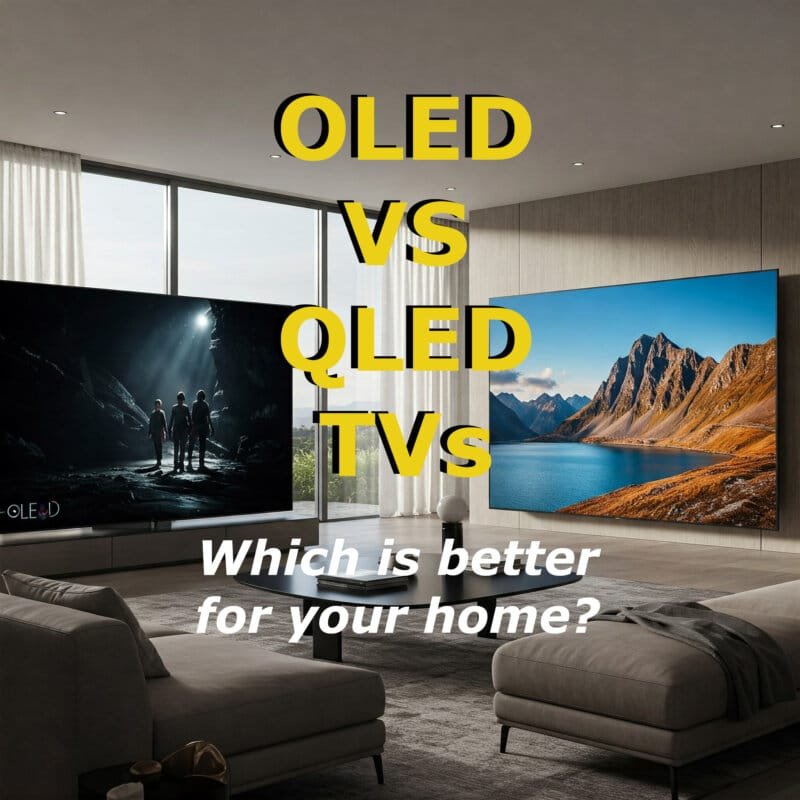OLED vs. QLED TVs in 2025: Which is Better for Your Home?
The TV market in 2025 is more advanced than ever, offering stunning picture quality, vibrant colors, and immersive viewing experiences. Two of the most popular technologies dominating the scene are OLED (Organic Light-Emitting Diode) and QLED (Quantum-dot Light-Emitting Diode). Both have their unique strengths, but which one is better for your needs? In this guide, we’ll break down the key differences between OLED and QLED TVs, helping you decide which technology is the right fit for your home.
Understanding OLED and QLED Technologies
What is OLED?
OLED TVs use self-emissive pixels, meaning each pixel produces its own light. This allows for perfect blacks, infinite contrast ratios, and precise color accuracy. Since there’s no need for a backlight, OLED TVs are incredibly thin and flexible. The ability to turn off individual pixels also makes OLED TVs highly energy-efficient, especially when displaying dark scenes.
What is QLED?
QLED TVs rely on a quantum-dot layer combined with an LED backlight to enhance brightness and color. While QLED panels can’t achieve true blacks like OLEDs, advancements in full-array local dimming (FALD) have significantly improved contrast. QLED TVs are known for their high brightness levels, making them ideal for brightly lit rooms.
Picture Quality: OLED vs. QLED
Black Levels and Contrast
- OLED: The ability to turn off individual pixels gives OLED TVs perfect blacks and an infinite contrast ratio, creating a more immersive viewing experience.
- QLED: While QLED TVs have improved with FALD, they still rely on a backlight, which can cause blooming (light bleeding into dark areas).
Brightness
- OLED: Typically peaks at 600–1,000 nits, making it great for dark or dimly lit rooms.
- QLED: Can reach 1,500–2,000 nits, making it ideal for bright rooms or HDR content in daylight.
Color Accuracy
- OLED: Offers natural color reproduction and better consistency across viewing angles.
- QLED: Thanks to quantum-dot technology, QLED TVs deliver vivid, bright colors with a higher color volume.
Viewing Angles and Motion Handling
Viewing Angles
- OLED: With self-emissive pixels, OLED TVs maintain consistent colors and contrast even at extreme angles.
- QLED: While newer models have improved, QLED TVs with VA panels can still show color and contrast degradation at wider angles.
Motion Handling
- OLED: Boasts a response time as low as 0.1 milliseconds, making it perfect for fast-paced gaming and sports.
- QLED: While newer models have higher refresh rates, QLED TVs generally have slightly slower response times, which can lead to motion blur in fast scenes.
Lifespan and Burn-in Concerns
Longevity
- OLED: Organic compounds in OLED TVs may degrade over time, potentially shortening their lifespan.
- QLED: LED backlighting in QLED TVs is more durable, offering a longer lifespan with less risk of degradation.
Burn-in Risk
- OLED: Prone to burn-in if static images (like channel logos or gaming HUDs) are displayed for too long. Modern OLED TVs have features like pixel-shifting to reduce this risk.
- QLED: No risk of burn-in, making it a safer choice for gaming or watching content with static elements.
Price and Value for Money
- OLED: Generally more expensive due to advanced self-emissive technology. High-end models from brands like LG, Sony, and Panasonic come with premium price tags.
- QLED: Offers a wider range of prices, from budget-friendly options to premium models. Brands like Samsung, TCL, and Hisense provide excellent value for larger screen sizes and high brightness.
Ideal Use Cases: OLED vs. QLED
When to Choose OLED
- Cinematic experience: Perfect for deep blacks, high contrast, and a theater-like feel.
- Dark room viewing: OLED’s self-emissive pixels shine in dimly lit environments.
- Wide viewing angles: Great for family rooms where viewers sit at different angles.
- Gaming: With near-instant response times, OLED is ideal for fast-paced gaming.
When to Choose QLED
- Bright rooms: Higher brightness levels make QLED better for daylight viewing.
- Budget-conscious buyers: QLED offers more affordable options with larger screens.
- Static image usage: No risk of burn-in, making it great for news, sports, or gaming HUDs.
- Longevity: QLED TVs are more durable over time.
OLED vs. QLED TVs: A Detailed Comparison
| Feature | OLED | QLED |
|---|---|---|
| Picture Quality | Perfect blacks, infinite contrast, natural colors | Bright, vivid colors, good contrast (with FALD) |
| Brightness | 600–1,000 nits (ideal for dark rooms) | 1,500–2,000 nits (great for bright rooms) |
| Viewing Angles | Excellent (consistent colors and contrast) | Good (color/contrast degrades at wider angles) |
| Motion Handling | 0.1ms response time (perfect for gaming) | Slightly slower (motion blur in fast scenes) |
| Burn-in Risk | Possible (static images over time) | None (no risk of burn-in) |
| Lifespan | Shorter (organic compounds degrade) | Longer (LED backlighting is more durable) |
| Price | More expensive (premium technology) | Budget-friendly to premium options |
| Best For | Dark rooms, cinematic experience, gaming | Bright rooms, static content, budget buyers |
Final Verdict: Which is Better in 2025?
While both OLED and QLED TVs deliver outstanding picture quality, the better choice ultimately depends on your specific needs and viewing environment. However, if we had to pick a winner for 2025, OLED takes the crown for most users due to its superior contrast, perfect blacks, and cinematic experience. That said, QLED remains a fantastic option for specific use cases.
Why OLED is the Better Choice for Most People
OLED’s self-emissive technology allows it to achieve perfect blacks and an infinite contrast ratio, creating a viewing experience that’s unmatched by QLED. This makes OLED ideal for dark room viewing, home theaters, and anyone who prioritizes cinematic immersion. Additionally, OLED’s near-instant response time and wide viewing angles make it the best choice for gaming and family rooms where viewers sit at different angles.
While OLED TVs are generally more expensive, the premium picture quality and future-proof technology justify the investment for most users. Modern OLED models also come with features like pixel-shifting and screen-refreshing to minimize burn-in risks, making them more durable than ever.
When QLED is the Better Option
QLED is the better choice if you need a TV for a bright room or want a budget-friendly option with larger screen sizes. Its higher brightness levels (up to 2,000 nits) make it ideal for daylight viewing, and its lack of burn-in risk makes it a safer choice for static content like news tickers or gaming HUDs. QLED also offers better longevity, as its LED backlighting is less prone to degradation over time.
Top Recommendations
The Bottom Line
If you’re looking for the best overall picture quality and don’t mind spending a bit more, OLED is the clear winner in 2025. However, if you need a TV for a bright room, want to save money, or prioritize longevity, QLED is an excellent alternative. By understanding these differences, you can confidently choose the perfect TV for your home.

